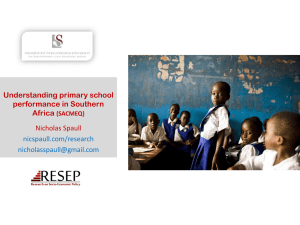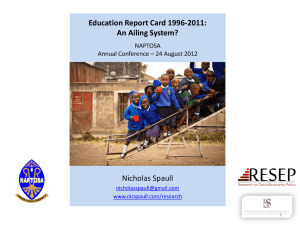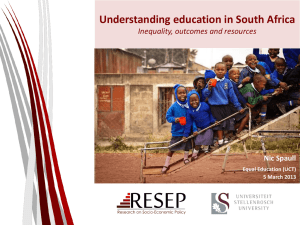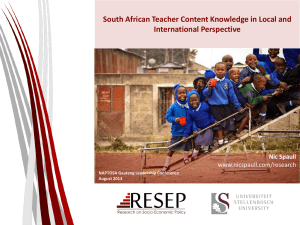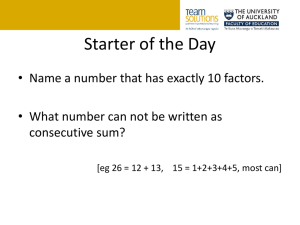Equal Education presentation - Nic Spaull
advertisement
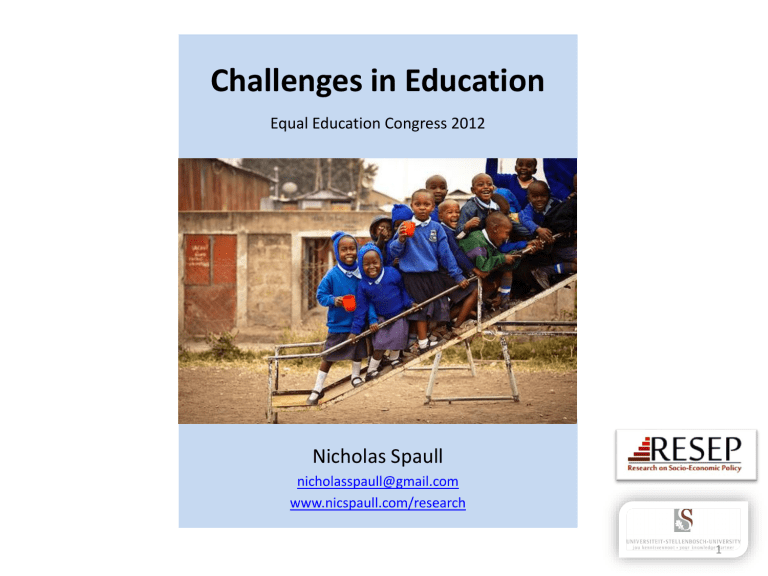
Challenges in Education Equal Education Congress 2012 Nicholas Spaull nicholasspaull@gmail.com www.nicspaull.com/research 1 Outline 1) Background: – 2) South African student performance (2003-2011) – – 3) Two education systems not one: Teacher knowledge and student knowledge 2 significant improvements – – 4) Government expenditure on education Workbooks ANA’s Accountability – Teacher absenteeism 5) Conclusion: 3 biggest challenges 6) Way forward 2 Expenditure on education 2010/11 Total government expenditure Government exp on education (31% GDP in 2010/11 – R733.5bn) (19.5% of Gov exp: R143.1bn) 17% 5% Other Government spending 80,50% Education: Other current 19,50% 78% Education: Capital Education: Personnel Education exp = 6.1% of GDP Personnel exp = 78% of educ exp Personnel exp = 4.8% of GDP 3 Student performance 2003-2011 TIMSS (2003) PIRLS (2006) SACMEQ (2007) NSES (2008-10) ANA (2011) TIMSS 2003 (Gr8 Maths & Science) PIRLS 2006 (Gr 4/5 – Reading) • Out of 50 participating countries (including 6 African countries) SA came last SA came SACMEQ 2007 (Gr6 – Reading & Maths) • Out of III 45 participating countries last •• Only 10% reached low international benchmark 87% of gr4 and 78% of Gr 5 learners deemed to be •NSES No improvement from TIMSS 1999-TIMSS 2003 “at2008-2010 serious risk of not learning to read” (Gr 3-5 – and Reading & maths Maths) • SA came 10/15 for reading 8/15 for behind countries such as Swaziland, Kenya and Tanzania •ANA 27% of gr6 students functionally illiterate Mean literacy score gr3: 19.4% 2011 (Gr 1-6 Reading & Maths) • 40% of gr6 students functionally innumerate • •• • • • • Mean numeracy score gr3: 28.4% Gr 3 Black children in gr3: former white Mean literacy score 35% schools scored higher on the same test Mean numeracy score in gr3: 28% Black than Gr5 Black children former Mean schoolsliteracy score gr6: 28% Mean numeracy score gr6: 30% More than 80% of quintile 1,2,3 schools scored a SCHOOL average (across grades 1-6) of less than 50% 4 SA primary school: Gr6 Literacy – SACMEQ III (2007) Never enrolled 2% Functionally illiterate 25% Basic skills 46% Higher order skills : 27% 5 Grade 6 Literacy 1% SA Gr 6 Literacy 25% 5% Kenya Gr 6 Literacy 7% 49% 46% SA public current expenditure Kenya public current expenditure per pupil: $1225 per pupil: $258 39% 27% 6 2 education systems Dysfunctional Schools (75%) Functional Schools (25%) Weak accountability Strong accountability Incompetent school management Good school management Lack of culture of learning, discipline and order Culture of learning, discipline and order Inadequate LTSM Adequate LTSM Weak teacher content knowledge Adequate teacher content knowledge High teacher absenteeism (1 month/yr) Low teacher absenteeism (2 week/yr) Slow curriculum coverage, little homework or testing Covers the curriculum, weekly homework, frequent testing High repetition & dropout (Gr10-12) Low repetition & dropout (Gr10-12) Extremely weak learning: most students fail standardised tests Adequate learner performance (primary and matric) 7 Grade 3 Numeracy (V-ANA 2011) Correct answer (15cm): 40% of Gr 3 students Verification ANA Gr3 Numeracy (Quest 18) Quintile 1 2 3 4 5 Total Wrong 63% 68% 63% 57% 42% 60% Right 37% 32% 37% 43% 58% 40% Total 100% 100% 100% 100% 100% 100% 8 Grade 6 Numeracy (V-ANA 2011) Correct answer (90 litres): 32% of Gr 6 students Verification ANA 2011 Gr6 Numeracy (Quest 25.1) Quintile 1 2 3 4 5 Total Wrong 74% 75% 70% 68% 50% 68% Right 26% 25% 30% 32% 50% 32% Total 100% 100% 100% 100% 100% 100% 9 Teacher knowledge SACMEQ III (2007) 401/498 Gr6 Mathematics teachers 7 Correct answer (7km): 38% of Gr 6 SACMEQ Maths teacher test Q17 Correct 1 23% 2 22% Quintile 3 38% Maths teachers 4 40% 5 74% Avg 38% 2 education systems 10 Teacher knowledge... Maths teacher content knowledge (SACMEQ III) Source: Stephen11Taylor 2 Significant improvements (2010/11) 1. Workbooks – – – – A workbook for every child for maths and language High quality learning/teaching resources Helps teacher pace learning & cover curriculum 4 worksheets/term ; 8 weeks/term ; 2 terms per volume (4 workbooks per year – 2 for maths and 2 for language 2. Annual National Assessments – – – – – Every child in Grades 1-6 tested in numeracy and literacy 2 main aims are (1) accountability, and (2) support Provide comparable information on student learning & school performance Provide benchmarks for grade-appropriate assessment Support can be targeted to specific schools, teachers and learners 12 Grade R books attend to conceptual and perceptual development. 13 Source: Veronica McKay Source: Veronica McKay 14 Grade 4 – Genre – Time table Source: Veronica McKay 15 Grade 1 – Isixhosa Source: Veronica McKay 16 Grade 2 Assessment 17 Accountability: teacher absenteeism (SACMEQ III – 2007 – 996 teachers) Non-strike teacher absenteeism SACMEQ III (2007) 25 20 4th/15 15 Days per year 10 19 5 6 7 8 8 9 9 10 10 11 11 12 14 14 14 0 18 Accountability: teacher absenteeism (SACMEQ III – 2007 – 996 teachers) Self-reported teacher absenteeism (days) 15th/15 SACMEQ III (2007) Non-strike teacher absenteeism Teachers' strikes 25 20 0 15 0 Days per year 0 10 0 0 5 7 0 8 9 9 10 10 0 11 12 2 0 19 0 0 6 0 0 0 12 14 11 14 14 8 0 20 days 19 (1 month) Accountability: teacher absenteeism (SACMEQ III – 2007 – 996 teachers) Western Cape Eastern Cape Limpopo % absent > 1 week striking 32% 81% 97% % absent > 1 month (20 days) 22% 62% 48% % absent > 3 months (60 days) 2% 9% 0% 1.9 days a week 20 3 biggest challenges 1.Failure to get the basics right • • Children who cannot read, write and compute properly (Functionally illiterate/innumerate) after 6 years of formal full-time schooling Often teachers lack even the most basic knowledge 2.Inequality in education • • • 2 education systems – dysfunctional system operates at bottom of African countries, functional system operates at bottom of developed countries. More resources is NOT the silver bullet – we are not using existing resources Why does SA do worse than most other POORER African countries? 3.Lack of accountability • • • Little accountability to parents in majority of school system Little accountability between teachers and Department Teacher unions abusing power and acting unprofessionally 21 Way forward? 1. Acknowledge the extent of the problem • • Low quality education is one of the three largest crises facing our country (along with HIV/AIDS and unemployment). Need the political will and public support for widespread reform. The education system is improving but that doesn’t mean we aren’t still in crisis 2. Focus on the basics • • • • • Every child MUST master the basics of foundational numeracy and literacy these are the building blocks of further education – weak foundations = recipe for disaster Teachers need to be in school teaching (re-introduce inspectorate?) Every teacher needs a minimum competency (basic) in the subjects they teach Every child (teacher) needs access to adequate learning (teaching) materials Use every school day and every school period – maximise instructional time 3. Increase information, accountability & transparency • • • At ALL levels – DBE, district, school, classroom, learner Strengthen ANA and give student results to every parent Set realistic goals for improvement and hold people accountable 22 References • • • • • • • • • • Fleisch, B. (2008). Primary Education in Crisis: Why South African schoolchildren underachieve in reading and mathematics. Cape Town. : Juta & Co. Hoadley, U. (2010). What doe we know about teaching and learning in primary schools in South Africa? A review of the classroombased research literature. Report for the Grade 3 Improvement project of the University of Stellenbosch. Western Cape Education Department. Hungi, N., Makuwa, D., Ross, K., Saito, M., Dolata, S., van Capelle, F., et al. (2011). SACMEQ III Project Results: Levels and Trends in School Resources among SACMEQ School Systems. Paris: Southern and Eastern Africa Consortium for Monitoring Educational Quality. Ross, K., Saito, M., Dolata, S., Ikeda, M., Zuze, L., Murimba, S., et al. (2005). The Conduct of the SACMEQ III Project. In E. Onsomu, J. Nzomo, & C. Obiero, The SACMEQ II Project in Kenya: A Study of the Conditions of Schooling and the Quality of Education. Harare: SACMEQ. Shepherd, D. (2011). Constraints to School Effectiveness: What prevents poor schools from delivering results? Stellenbosch Economic Working Papers 05/11. [PIRLS] Spaull, N. (2011a). A Preliminary Analysis of SACMEQ III South Africa.Stellenbosch Economic Working Papers. Spaull, N. (2011). Primary School Performance in Botswana, Mozambique, Namibia and South Africa. Paris: Southern and Eastern African Consortium for Monitoring Educational Quality (SACMEQ) Working Paper no.8. Spaull, N. 2012 Equity & Efficiency in South African primary schools : a preliminary analysis of SACMEQ III South Africa Masters Thesis. Economics. Stellenbosch University Taylor, S. (2011). Uncovering indicators of effective school management in South Africa using the National School Effectiveness Study.Stellenbosch Economic Working Papers 10/11, 1-51. [NSES] Van der Berg, S., Burger, C., Burger, R., de Vos, M., du Rand, G., Gustafsson, M., Shepherd, D., Spaull, N., Taylor, S., van Broekhuizen, H., and von Fintel, D. (2011). Low quality education as a poverty trap. Stellenbosch: University of Stellenbosch, Department of Economics. Research report for the PSPPD project for Presidency. 23 Thank you www.nicspaull.com/research nicholasspaull@gmail.com @NicSpaull 24 25 2 education systems .015 .01 0 .005 Density .02 .025 Ex-Department NSES Gr 4 (Taylor, 2011) 0 20 40 60 Numeracy score 2008 Ex-DET/Homelands schools 80 100 Historically white schools .008 .005 Taylor, 2011 .004 .006 Socioeconomic status SACMEQ Gr 6 (Spaull, 2011) 0 0 .001 .002 .002 Density .003 .004 Language PIRLS Gr 5 (Shepherd, 2011) 0 0 200 400 reading test score African language schools 600 800 English/Afrikaans schools 200 400 600 Learner Reading Score Poorest 25% Second wealthiest 25% 800 Second poorest 25% Wealthiest 25% 1000 26 Teacher knowledge... Q6: 53% correct (D) Q9: 24% correct (C) English Q9: 57% correct (D) 27 Accountability: teacher absenteeism (SACMEQ III – 2007 – 996 teachers) Total teacher abseteeism (days) Percentage Percentage Teacher absent for > 1 absent for > 1 strikes only week due to month due to (days) strikes strikes Percentage absent > 1 month Percentage absent > 2 month Percentage absent > 3 month ECA 22 14 81% 0% 62% 12% 9% FST 17 9 62% 3% 25% 7% 2% GTN 12 6 41% 0% 16% 3% 3% KZN 26 15 82% 56% 73% 10% 5% LMP 21 14 97% 0% 48% 0% 0% MPU 24 13 87% 9% 48% 6% 4% NCA 18 11 62% 32% 50% 2% 0% NWP 19 10 73% 8% 45% 11% 8% WCA 11 5 32% 12% 22% 5% 2% Total 20 12 71% 24% 47% 7% 4% 28
